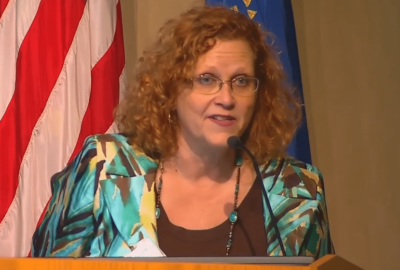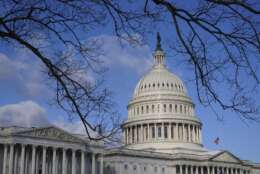
‘How do we do better?’ Chief data officers see hiring challenges persist
Chief data offiers face a long road ahead, not just getting their agencies to adopt the culture change of data-driven government, but also finding a workforce and...
Best listening experience is on Chrome, Firefox or Safari. Subscribe to Federal Drive’s daily audio interviews on Apple Podcasts or PodcastOne.
The Trump administration made chief data officers a foundational element to the success of its Federal Data Strategy, as well as the Foundations for Evidence-Based Policymaking Act.
However, CDOs still face a long road ahead, not just getting their agencies to adopt the culture change of data-driven government but also finding a workforce and the resources to carry out their new mission.
In a survey of more than 100 government data professionals, a study by REI Systems, ACT-IAC and Johns Hopkins University found that 82% of respondents said data analytics had a “dominant” or “significant” impact on their job. But finding time in the workday to conduct that data analysis, they said, remains a challenge.

When asked to rank how much time they spent on a handful of certain analytics-related activities, respondents said they spent 23% of their time gathering data, and about 17% percent on “work not related to analytics.”
Other top activities included analyzing the data (8%) and explaining the results of their data analysis (14%).
Meanwhile, the Office of Management and Budget has taken steps to bring CDOs together, and in September held an orientation and Evidence Act training session.
Michael Conlin, the CDO of the Defense Department, told Federal News Network that the training focused on building a common set of expectations for agencies to follow in implementing the administration’s policy documents on data.
At the OMB orientation, which Conlin said included 50-60 data officials from across the government, chief data officers were given a presentation on a Harvard University study, based on data from both the Census Bureau and the IRS, that found a correlation between a person’s hometown and their economic mobility.
While the study aimed to demonstrate the value of combing disparate data elements from different agencies, Conlin said DoD is doing some “serious number-crunching” to see if it can build off the results of the study to reach new conclusions relevant to service members.
“Does enlisting in the department increase your economic mobility – particularly your upward economic mobility – as a human being? We’ve had some conversations, we think we have some executive sponsors for that [and] a set of questions. We’re looking at how do we bring that data, to merge it with data that we’ve got, and test not only whether we’ve had a positive impact of economic mobility … [but] can we improve the impact that we’re having,” he said during panel discussion. “This is ultimately the question: How do we do better?”
While the Evidence Act created new C-suite positions across government — CDOs and chief evaluation officers — and laid out new goals for agencies to meet, neither the legislation nor the Federal Data Strategy has given these officials new authorities or funding to fulfill their mission.
“It’s ‘Do more with what you have or with less, ‘ depending on how your budgets go,” Conlin said. “That’s not a new challenge for anybody in government, it’s not a new challenge for anybody in any commercial sector organization either.”
William Wiatrowski, the deputy secretary of the Bureau of Labor Statistics, said the Evidence Act has enabled “real pushes for agencies to share information where there aren’t restrictions,” but breaking down those data siloes remains a challenge elsewhere in government.
“The practical matter is, I can’t force somebody to let me have access to their data sets,” Conlin said. “I must persuade them that it is in their interest to provide that data to answer their boss’s question in a different way than they can do it today.”
If CDOs seeking data get pushback from other agencies, the Evidence Act urges them to rely more on administrative records.
Pat Hu, the associate administrator and director of the Bureau of Transportation Statistics, said her agency has leaned more on those administrative records at a time when the budget resources spent on collect data are shrinking.
The agency, for example, is now using data from the app Waze to glean safety information on highways. That data, she added, allows state and local governments to better position emergency vehicles to respond to accidents faster and clear roadways more quickly.
“If I have a tool that allows me to know tomorrow’s safety trajectory, I can better position my operations,” Hu said.
Before most data projects can even get off the ground, Conlin said his team at DoD needs an agency executive to “sponsor” the project. That includes asking mission-based questions that the data team can then find answers to.
“If I don’t have an executive that is interested in the answers and it’s not aligned with their goals, I may be wasting the department’s resources, the taxpayers’ resources and the warfighters’ resources and I don’t want to do that,” he said.
But in order to build that level of engagement in the agency leadership, Conlin said his team have held “literacy classes” for Senior Executive Service-level leaders that focus on basic data quality and descriptive statistics skills. But in order to pull this off, Conlin said the training isn’t conducive to a classroom setting.
“You often need to deliver this in a one-on-one kind of scenario. They often feel uncomfortable with their lack of knowledge in front of their peers, and so you don’t put them in that situation where they might feel uncomfortable. That’s not productive,” he said.
Another reason for the tailored trained for leadership, Conlin added, is to make the subject material relevant to their mission focus.
“There’s no use talking to a financial executive about data that is not financial data. There’s no use talking to a transportation executive about data that has nothing to do with transportation,” he said.
Hiring, retention remains top data analyst challenge
Respondents to the survey said retention and hiring remained their biggest challenge, and senior data officials elsewhere in government say those data analysis skills remain in high demand.
Faced with challenges in trying to recruit the same pool of talent as the private sector, Emily Knickerbocker, the CDO at the Small Business Administration, said her team at has been trying to retrain and develop data skills with the workforce the agency already has.
Related Stories

It’s been a big year so far for the government’s push toward better data governance

NIH to hire chief data science strategist as part of its drive to harness big data
SBA, for example, has long employed statisticians who have worked on predictive modeling, but don’t fit the role of “data scientist.”
“Data science is a more recently coined term, but I think a lot of the skills that can be used to draw insights from data, we have people that have been doing this work for a long time,” Knickerbocker said.
Dan Cain, a senior adviser for the Bureau of the Fiscal Service’s enterprise-wide data strategy, said the bureau had recently started its own recruitment push for data talent, but has had problems finding the talent the agency needs.
“I think if you want to find a hard-core data scientist who has experience in [artificial intelligence] or predictive analytics, I think that’s pretty challenging,” Cain said. “But at the lower level of sophistication, where you just want someone who maybe has exposure to R and Python and you’re willing to do a little bit of training, we’ve had OK success.”
One of the challenges is the lack of a federal job series for data scientists. The Federal Data Strategy tasks the Office of Personnel Management with producing one, and the agency expects to finish work by November.
Having a new job series from OPM, Cain said, would help “carve out a path” for new data-centric hires. Otherwise, “you have to kind of shoehorn some different position descriptions,” he said.
How to train the workforce when ‘the technology moves way too fast’
More than 50% percent of survey respondents said their agency plans to develop or recruit staff with some analytics certification. But other data experts said with the rapid pace of technology, what that level of training looks like remains unclear.
Hu said her agency has a fellowship where recent graduates work in three-year stints at the agency, then educate staff on everything from data visualization to data curation.
“The idea of the fellows program is I can’t train my existing staff fast enough, because the technology moves way too fast,” Hu said.
BTS employees still receive regular training. Hu said the agency has a session scheduled to help employees “tell a story” through their data projects.
Wiatrowski said BLS has a civic digital fellowship, in which up to a dozen college students work on data-centric projects alongside current employees.
“We made a point of linking them with staff so that those projects could continue and we get more things done … we can’t train people fast enough, and so we will take all the help that we can possibly get,” he said.
The first-year action of the Federal Data Strategy also addresses this data needs gap, and tasks agencies with identifying the skills they’ll need for data analysis, assessing current their staff capacity for those skills and then draft plans to address those skills gaps.
The strategy also tasks the General Services Administration with creating an inventory of data science training and credentialing opportunities for agencies.
Agencies not yet implementing AI
For all the challenges surrounding data in the federal government, a lack of data isn’t one of those problems. In order to sort through terabytes and petabytes of information, the Trump administration has looked to artificial intelligence to help with the rote work of labeling and categorizing data.
But survey respondents said the hype around AI hasn’t yet materialized into concrete action. A quarter of the survey respondents said AI “holds promise” for their agencies, but only 4% said their agencies had actually implemented AI or machine learning solutions.
More Technology News
“A lot of the success that the Bureau of Labor Statistics has had in using machine learning and other analytics is some typically younger person saying ‘Why am I sitting here, day after day, going through this boring data and turning it into codes and publishing it? There’s got to be a better way,’” he said.
The bureau, he added, has also begun using natural language processing to produce BLS news releases for monthly data reports, freeing up more time for employees.
“We think that natural language processing is going to write the first draft of the news release [but] there will always be human” going over the final copy,” Wiatrowski said.
So how will CDOs know that they’ve made a difference at their agencies?
Conlin said that be the most important data analysis for CDOs to measure.
“I don’t like to put the emphasis on the word innovation or digitization. I want the emphasis to be on the outcomes …. If we cannot measure our effectiveness, then we’re not complying with the letter or the spirit of any of the documents we’ve been talking about,” he said.
Copyright © 2025 Federal News Network. All rights reserved. This website is not intended for users located within the European Economic Area.
Jory Heckman is a reporter at Federal News Network covering U.S. Postal Service, IRS, big data and technology issues.
Follow @jheckmanWFED






